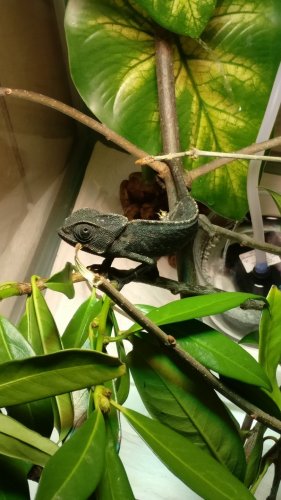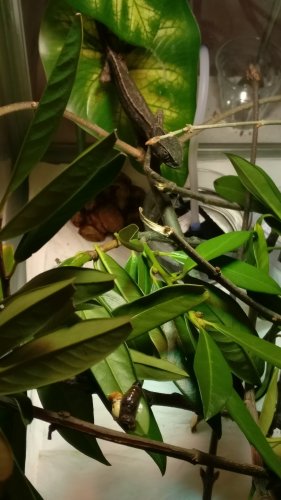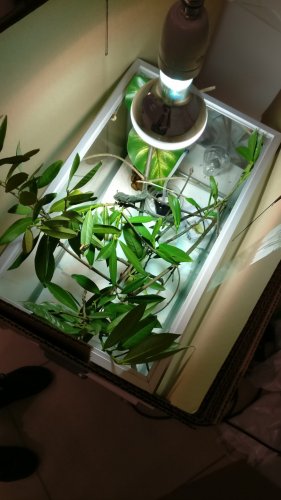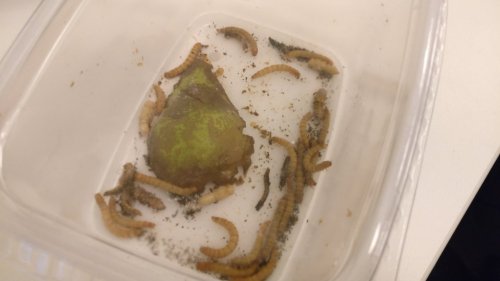Hello!
This is my first post on any chameleon community so i hope everything makes sense.
Before i get started:
We didn't expect to get a chameleon, since we got him from a guy that took him from his homeland but didn't want to give him proper care (i know, friggin asshole). So we have just been trying to get the right information from the internet, but i'm pretty sure he haven't been living in optimal conditions since we got him. But we are not giving up on this little guy, so we need your help.

About my chameleon:
I think he's a male since he got spurs on his back feet. Age about 3-4 weeks old. Been in our care for about 2 weeks. We try not to handle him at all since we think he's really stressed and handling him probably wont make that better. But we have had to force feed him a couple of time since he is not eating, we havent seen proof of him eating by himself once since we got him around 2 weeks ago. Currently we have a small box of live worms at the bottom of the tank, should be fully accessible for our chameleon. And i haven't seen any poo yet either (last second edit: he made a big poo! Included in pic below)... For food we are using worms around 2cm long, when we force feed him they're dusted with Repptivite with D3-vitamins. We have only done that two times so far. But he freaks out when we do that, poor little guy...

We have a dripper as a water source and i recently learned that you need to mist the cage for around 5 minutes, today i saw him go hide but when around 4 minutes in to the misting he came out again, so i believe thats a good sign? I'm using a regular water spray bottle with the finest mist option possible. Haven't seen him using the dripper to drink though. As mentioned, we didn't expect getting a baby veiled chameleon so mistakes have been made. He's had to change environment alot and probably handled a bit too much before he finally ended up at our office. We decided to take turn to take care for him during weekends.
Cage info:
Cage type is probably an old aquarium of glass, no roof, dimensions 30 x 50 x 30 cm (we are looking for a better option). For lighting we use a bulb with the brand Trixie and the info on the bulb: CS004 MAX 250W, AC220-240v 50/60Hz. And for temperature, basking spot, ~26 celsius, floor ~22celsius. Lowest overnite i would guess ~18-20 celsius. I'm sorry I have no idea about the humidity. Plants unsure, some co-workers picked them outside, Included in the pictures. The cage is located in my office, not so trafficated but sometimes people come in to look at him, we tell them to not scare him. Geographically he is located in south of sweden.

Main problem:
He is not eating on his own... He almoste seems to be scared of the worms. Sometimes he stands and look down on them for a long time. But never eats them. Would like to hear what you guys think should be the best solution to this problem.
Very thankful for any help!
Let me know if there are any more info i should add
This is my first post on any chameleon community so i hope everything makes sense.
Before i get started:
We didn't expect to get a chameleon, since we got him from a guy that took him from his homeland but didn't want to give him proper care (i know, friggin asshole). So we have just been trying to get the right information from the internet, but i'm pretty sure he haven't been living in optimal conditions since we got him. But we are not giving up on this little guy, so we need your help.

About my chameleon:
I think he's a male since he got spurs on his back feet. Age about 3-4 weeks old. Been in our care for about 2 weeks. We try not to handle him at all since we think he's really stressed and handling him probably wont make that better. But we have had to force feed him a couple of time since he is not eating, we havent seen proof of him eating by himself once since we got him around 2 weeks ago. Currently we have a small box of live worms at the bottom of the tank, should be fully accessible for our chameleon. And i haven't seen any poo yet either (last second edit: he made a big poo! Included in pic below)... For food we are using worms around 2cm long, when we force feed him they're dusted with Repptivite with D3-vitamins. We have only done that two times so far. But he freaks out when we do that, poor little guy...

We have a dripper as a water source and i recently learned that you need to mist the cage for around 5 minutes, today i saw him go hide but when around 4 minutes in to the misting he came out again, so i believe thats a good sign? I'm using a regular water spray bottle with the finest mist option possible. Haven't seen him using the dripper to drink though. As mentioned, we didn't expect getting a baby veiled chameleon so mistakes have been made. He's had to change environment alot and probably handled a bit too much before he finally ended up at our office. We decided to take turn to take care for him during weekends.
Cage info:
Cage type is probably an old aquarium of glass, no roof, dimensions 30 x 50 x 30 cm (we are looking for a better option). For lighting we use a bulb with the brand Trixie and the info on the bulb: CS004 MAX 250W, AC220-240v 50/60Hz. And for temperature, basking spot, ~26 celsius, floor ~22celsius. Lowest overnite i would guess ~18-20 celsius. I'm sorry I have no idea about the humidity. Plants unsure, some co-workers picked them outside, Included in the pictures. The cage is located in my office, not so trafficated but sometimes people come in to look at him, we tell them to not scare him. Geographically he is located in south of sweden.

Main problem:
He is not eating on his own... He almoste seems to be scared of the worms. Sometimes he stands and look down on them for a long time. But never eats them. Would like to hear what you guys think should be the best solution to this problem.
Very thankful for any help!
Let me know if there are any more info i should add




